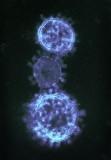A pair of reports on the Middle East respiratory syndrome coronavirus (MERS-CoV) brought a mix of bad news and good news this week on the transmission and control of the disease.
Writing in The Lancet Infectious Diseases, an international research team estimated that at least 62% of symptomatic MERS cases are going undetected and that a "slowly growing epidemic is under way." But the team also said it is not clear whether the disease has gained the ability to keep spreading in humans without recurrent spillover infections from animals.
A larger group of researchers, in a lengthy review in PLoS Currents of what's known about the disease so far, observed that it has not achieved sustained human-to-human transmission and that outbreaks have been stopped without "overly aggressive" control efforts. And amid growing evidence that the virus exists in camels, the group also reported that only seven case-patients so far have reported contact with animals before they got sick.
The World Health Organization (WHO) has counted 153 confirmed MERS cases, including 64 deaths, since the disease emerged in 2012. Most of the cases have occurred in Saudi Arabia, and all have been linked directly or indirectly to the Middle East.
Missed cases
The estimate of missed cases comes from scientists from Imperial College London, the University of Edinburgh, and the Institut Pasteur in Paris.
The authors gathered data on the 111 confirmed and probable MERS cases identified through Aug 8 of this year. To estimate the number of undetected cases, they noted the four cases that occurred in visitors to Jordan, Qatar, Saudi Arabia, and the United Arab Emirates, and calculated the average length of their visits. Each of the visitors passed the virus to one or two other people after returning home.
On the assumption that the per-day risk of infection for the visitors was the same as for residents of the countries they visited, and in view of the number of reported cases in the Middle East, the authors estimated that the total number of symptomatic MERS cases up to Aug 8 was 940 (95% confidence interval [CI], 290-2,200). Given the confidence interval, that suggests that "at least 62% of clinically apparent cases have been missed," the report says.
The authors also used data on MERS case clusters and other information to estimate the basic reproduction number (R) for the disease—the number of additional cases generated by each case introduced in a susceptible population. An R value of 1 or greater signals that a disease can keep spreading.
"Analysis of human clusters indicated that chains of transmission were not self-sustaining when infection control was implemented, but that R in the absence of controls was in the range 0.8-1.3," the report says. "Three independent data sources provide evidence that R cannot be much above 1, with an upper bound of 1.2-1.5."
The team also found that the size of clusters and the reproduction rate within clusters decreased with time, which might be explained by faster detection of and response to cases.
Many cases in animals?
The scientists also used MERS-CoV genetic data to come up with an estimate of the total number of infections in both animals and humans. This involved using estimates of the growth rate of the viral population derived from charting the diversity of genetic sequences, given that mutations occur at a specific rate as a virus replicates.
Using this method, the team estimated that 17,940 infections occurred in both humans and animals between March 2012 and Aug 8, 2013. The group's bottom line is that the virus is spreading, but it's unclear how much of the transmission is in animals and how much is in humans.
"Both the analysis of the genetic sequences and of the epidemic curves suggested that an epidemic is underway either in an animal reservoir or in man. These analyses do not allow us to distinguish between these scenarios and to determine whether MERS-CoV is currently self-sustaining in man," the report states.
However, it adds, "Our analysis demonstrates that the transmissibility of MERS-CoV in man is close to the critical threshold of R=1 required for self-sustaining transmission."
But if a human epidemic is actually going on, the relatively low estimated reproduction number and data on case clusters suggest that "intensive public health measures around cases, coupled with improved case ascertainment, are sufficient to contain spread and reduce morbidity and mortality."
Given that many cases are probably being missed, the reported cases "probably represent the severe end of a wide clinical spectrum of disease," the report states. Thus the case-fatality ratio (CFR) is probably lower than it looks now, though a CFR higher than 10% cannot be ruled out.
In an accompanying editorial, two Canadian scientists agree, saying the findings "suggest that mildly symptomatic cases are common, with implications for infection control measures." They are David N. Fisman, MD, MPH, and Ashleigh R. Tuite, MSc, MPH, of the Dalla Lana School of Public Health at the University of Toronto.
Fisman and Tuite praise the authors for crafting a careful analysis with data that are admittedly poor in quality. They note that several factors continue to discourage countries from promptly and fully sharing epidemiologic data, including reduced tourism, concerns about data security, and the desire to save data for publication in scientific journals.
"The ability to draw inferences about diseases from non-traditional data sources will hopefully both provide alternate means of characterizing epidemics, and diminish the temptation towards non-transparency in traditional public health authorities," Fisman and Tuite comment.
Review by WHO MERS-CoV Group
The other report, in PLoS Currents, was prepared by the WHO MERS-CoV Research Group, a very large team of authors from affected countries and many others. It offers a detailed epidemiologic and clinical portrait of the disease and concludes that sustained human transmission has not yet been seen.
"Outbreaks have been extinguished without overly aggressive isolation and quarantine suggesting that transmission of virus may be stopped with implementation of appropriate infection control measures," it states.
The review is based on 161 MERS-CoV cases—144 confirmed and 17 probable—reported between September 2012 and Oct 22, 2013. They included 65 deaths, 4 of which "could not be matched up to specific cases due to a lack of identifying information." Outcomes for another 45 cases were unknown, for various reasons.
The patients' median age was 50, and 64.5% were male. Nearly two thirds (63.4%) of cases were severe, and 76% of patients had at least one underlying medical condition, with such conditions more common in the fatal cases.
Twenty-nine cases were classified as sporadic (no links to other known cases), while 22 were classified as the first (index) cases in a cluster. Another 95 cases were listed as secondary because of links to other known cases, and 17 cases went unclassified because of lack of information.
Of the 95 secondary cases, 60 were believed to be infected in healthcare settings, 13 in households, and 1 in a workplace. The sporadic and index case-patients were older than secondary case-patients (median, 59 versus 43 years) and more likely to have severe disease.
Of 49 patients who answered the question, only 7 said they had been exposed to animals in the 10 days before their illness. Five of those reported contact with a camel, and the other two had contact with sheep.
On the question of human transmission, the report says estimates of R—including that of the Lancet Infectious Diseases report—suggest it is less than 1, though the upper range of some estimates exceeds 1.
GI symptoms common
On other topics, the WHO group said:
- Initial MERS symptoms typically include fever, cough, chills, sore throat, and muscle and joint pain, followed by dyspnea.
- At least a third of patients had gastrointestinal symptoms such as vomiting and diarrhea (see related news item about potential fecal-oral transmission of the virus).
- Many patients have been treated unsuccessfully with high-dose corticosteroids, and the WHO recommends against such treatment, with few exceptions.
- No antibiotic or antiviral agents have been effective in treating severe MERS cases.
- Unpublished data shows that MERS-CoV is closely related to coronaviruses found in hedgehogs (and various studies show it is related to coronaviruses in bats).
- Genetic analyses suggest that the virus emerged in mid-2011.
As for the mystery of the virus's source, the team said the apparent confinement of animal-to-human transmission to the Middle East suggests some clues: that the host species may have a restricted range and that exposures may be related to human behaviors that occur only in that region.
Regardless of which animal is the source of the virus, the team writes, "The primary question to be answered is the route of transmission from animal to human. . . . Prevention of transmission from the putative animal reservoir to humans is the critical step needed to halt the ongoing spread of this virus."
Surveillance geared to severe cases
Commenting on the two reports, Maria D. Van Kerkhove, PhD, who is a coauthor of both of them, said she believes cases are being missed because surveillance for MERS-CoV is geared to look for severe cases. "I think countries in the region have certainly stepped up surveillance activities in recent months, but we are still likely to miss the more mild or asymptomatic cases because current surveillance recommendations will not identify those," she told CIDRAP News by e-mail.
Experts have been debating whether the disease is self-sustaining in humans or is being continually renewed by transmission from animals to humans. Van Kerkhove, who is with the MRC Centre for Outbreak Analysis and Modeling at Imperial College London, commented, "I think we're seeing a combination of the two. There is certainly human-to-human transmission occurring, but we also continue to see a number of isolated cases reported without any epidemiologic links to other cases, indicating that there is likely non–human-to-human exposure occurring."
She said she is not surprised at this week's report that MERS-CoV has been found in a camel belonging to a MERS patient in Saudi Arabia, especially in light of recent serologic evidence of exposure to MERS-CoV or a similar virus in camels in Egypt, Oman, and the Canary Islands.
But she advised against reading too much into the finding that five MERS patients reported contact with camels: "These are very small numbers and should be interpreted with caution because we do not know what non-human exposures are leading to infection. We will only be able to determine this with case-control epidemiologic studies."
Cauchemez S, Fraser C, Van Kerkhove MD, et al. Middle East respiratory syndrome coronavirus: quantification of the extent of the epidemic, surveillance biases, and transmissibility. Lancet Infect Dis 2013 Nov 13 [Abstract]
Fisman DN, Tuite AR. The epidemiology of MERS-CoV. (Commentary) Lancet Infect Dis 2013 Nov 13 [Excerpt]
The WHO MERS-CoV Research Group. State of knowledge and data gaps of Middle East respiratory syndrome coronavirus (MERS-CoV) in humans. PLoS Currents 2013 Nov 12 [Full text]




















